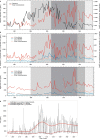Chiral monoterpenes reveal forest emission mechanisms and drought responses
- PMID: 36071188
- PMCID: PMC9452298
- DOI: 10.1038/s41586-022-05020-5
Chiral monoterpenes reveal forest emission mechanisms and drought responses
Abstract
Monoterpenes (C10H16) are emitted in large quantities by vegetation to the atmosphere (>100 TgC year-1), where they readily react with hydroxyl radicals and ozone to form new particles and, hence, clouds, affecting the Earth's radiative budget and, thereby, climate change1-3. Although most monoterpenes exist in two chiral mirror-image forms termed enantiomers, these (+) and (-) forms are rarely distinguished in measurement or modelling studies4-6. Therefore, the individual formation pathways of monoterpene enantiomers in plants and their ecological functions are poorly understood. Here we present enantiomerically separated atmospheric monoterpene and isoprene data from an enclosed tropical rainforest ecosystem in the absence of ultraviolet light and atmospheric oxidation chemistry, during a four-month controlled drought and rewetting experiment7. Surprisingly, the emitted enantiomers showed distinct diel emission peaks, which responded differently to progressive drying. Isotopic labelling established that vegetation emitted mainly de novo-synthesized (-)-α-pinene, whereas (+)-α-pinene was emitted from storage pools. As drought progressed, the source of (-)-α-pinene emissions shifted to storage pools, favouring cloud formation. Pre-drought mixing ratios of both α-pinene enantiomers correlated better with other monoterpenes than with each other, indicating different enzymatic controls. These results show that enantiomeric distribution is key to understanding the underlying processes driving monoterpene emissions from forest ecosystems and predicting atmospheric feedbacks in response to climate change.
© 2022. The Author(s).
Conflict of interest statement
The authors declare no competing interests.
Figures











References
-
- Engelhart GJ, Asa-Awuku A, Nenes A, Pandis SN. CCN activity and droplet growth kinetics of fresh and aged monoterpene secondary organic aerosol. Atmos. Chem. Phys. 2008;8:3937–3949.
-
- Laothawornkitkul J, Taylor JE, Paul ND, Hewitt CN. Biogenic volatile organic compounds in the Earth system. New Phytol. 2009;183:27–51. - PubMed
-
- Yáñez-Serrano AM, et al. Monoterpene chemical speciation in a tropical rainforest: variation with season, height, and time of day at the Amazon Tall Tower Observatory (ATTO) Atmos. Chem. Phys. 2018;18:3403–3418.
-
- Jardine KJ, et al. Monoterpene ‘thermometer’ of tropical forest-atmosphere response to climate warming. Plant Cell Environ. 2017;40:441–452. - PubMed
MeSH terms
Substances
LinkOut - more resources
Full Text Sources
Research Materials

